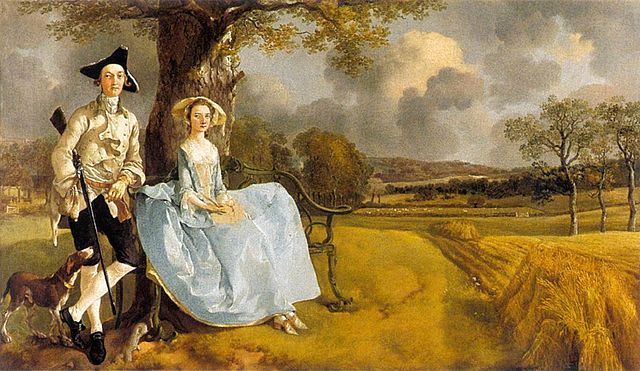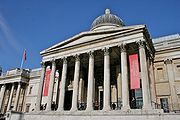
File:Mr and Mrs Andrews 1748-49.jpg

| |
This is a file from the Wikimedia Commons. Information from its description page there is shown below.
Commons is a freely licensed media file repository. You can help. |
Summary
| Artist |
|
||||||||||||||||||||
| Title | Mr and Mrs Andrews | ||||||||||||||||||||
| Date | between 1748 and 1749 | ||||||||||||||||||||
| Medium | oil on canvas | ||||||||||||||||||||
| Dimensions | Height: 70 cm (27.6 in). Width: 119 cm (46.9 in). | ||||||||||||||||||||
| Current location |
|
||||||||||||||||||||
| Source/Photographer | Web Gallery of Art: |
||||||||||||||||||||
Licensing
The official position taken by the Wikimedia Foundation is that "faithful reproductions of two-dimensional public domain works of art are public domain, and that claims to the contrary represent an assault on the very concept of a public domain". For details, see Commons:When to use the PD-Art tag. |
File usage
Metadata
| JPEG file comment | GAINSBOROUGH, Thomas (b. 1727, Sudbury, d. 1788, London) Mr and Mrs Andrews 1748-49 Oil on canvas, 70 x 119 cm National Gallery, London Robert Andrews and his wife Frances Mary, née Carter, were married in 1748, not long before Gainsborough painted their portraits - and that of Auberies, their farm near Sudbury. The church in the background is St Peter's, Sudbury, and the tower to the left is that of Lavenham church. The small full-length portrait in an open-air rustic setting is typical of Gainsborough's early works, painted in his native Suffolk after his return from London; the identifiable view is unusual, and may have been specified by the patrons. We must not imagine that they sat together under a tree while Gainsborough set up his easel among the sheaves of corn; their costumes were most likely painted from dressed-up artist's mannequins, which may account for their doll-like appearance, and the landscape would have been studied separately. This kind of picture, commissioned by people 'who lived in rooms which were neat but not spacious', in Ellis Waterhouse's happy phrase about Gainsborough's contemporary Arthur Devis, was a speciality of painters who were not 'out of the top drawer'. The sitters, or their mannequin stand-ins, are posed in 'genteel attitudes' derived from manuals of manners. The nonchalant Mr Andrews, fortunate possessor of a game licence, has his gun under his arm; Mrs Andrews, ramrod straight and neatly composed, may have been meant to hold a book, or, it has been suggested, a bird which her husband has shot. In the event, a reserved space left in her lap has not been filled in with any identifiable object. Out of these conventional ingredients Gainsborough has composed the most tartly lyrical picture in the history of art. Mr Andrews's satisfaction in his well-kept farmlands is as nothing to the intensity of the painter's feeling for the gold and green of fields and copses, the supple curves of fertile land meeting the stately clouds. The figures stand out brittle against that glorious yet ordered bounty. But how marvellously the acid blue hooped skirt is deployed, almost, but not quite, rhyming with the curved bench back, the pointy silk shoes in sly communion with the bench feet, while Mr Andrews's substantial shoes converse with tree roots. (The faithful gun dog had better watch out for his unshod paws.) More rhymes and assonances link the lines of gun, thighs, dog, calf, coat; a coat tail answers the hanging ribbon of a sun hat; something jaunty in the husband's tricorn catches the corner of his wife's eye. Deep affection and naive artifice combine to create the earliest successful depiction of a truly English idyll.
Author: GAINSBOROUGH, Thomas Title: Mr and Mrs Andrews Time-line: 1751-1800 School: English Form: painting Type: portrait |
|---|
Find out more
Wikipedia for Schools was collected by SOS Children's Villages. SOS Children cares for children who have lost their parents. Our Children's Villages give these children a new home and a new family, while a high-quality education and the best of medical care ensures they will grow up with all they need to succeed in adult life. Sponsoring a child is a great way to help children who need your support.



